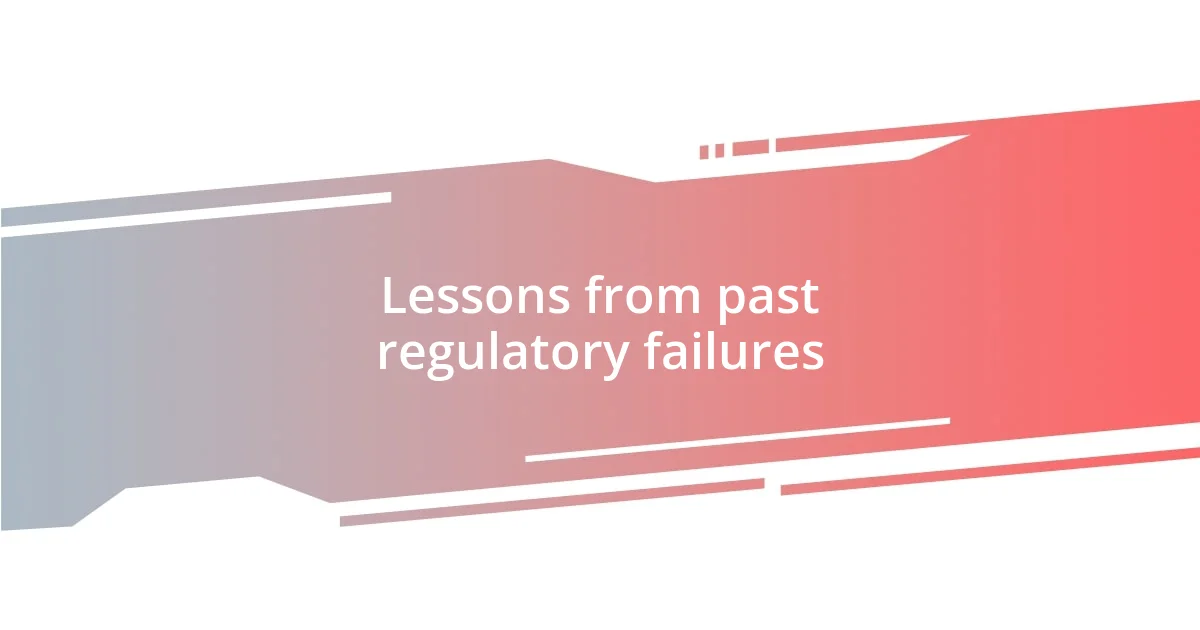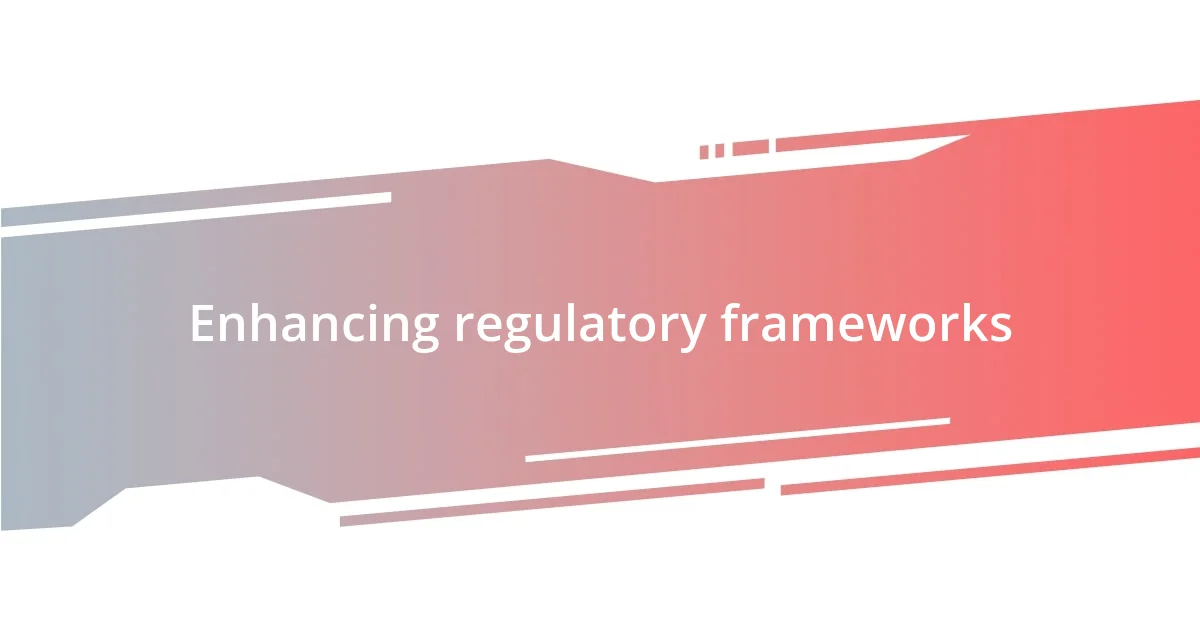Key takeaways:
- Regulatory failures can have severe real-world consequences, highlighting the need for clear, enforceable regulations and an engaged regulatory process.
- Striking a balance between stringent regulations and fostering innovation is crucial to avoid stifling progress, as seen in various sectors like finance and healthcare.
- Building a culture of compliance through open communication, education, and recognition can significantly enhance adherence to regulations and improve overall trust in regulatory systems.

Understanding regulatory failures
Regulatory failures occur when the established systems and guidelines intended to protect the public and maintain fair practices falter. I’ve witnessed this firsthand in industries like finance and healthcare, where a lack of oversight can lead to devastating consequences. Have you ever wondered how something could slip through the cracks, only to cause chaos later?
One moment that stands out to me was seeing the fallout from a significant cybersecurity breach in a healthcare organization. It shook me to realize how inadequate regulatory measures could expose sensitive patient data and compromise trust, illustrating that regulations aren’t just abstract policies but crucial safeguards for our well-being. Can we truly afford to overlook the implications when regulations fail, especially when lives are on the line?
Reflecting on various regulatory failures, I often find myself questioning whether these systems were simply too complex, or if there was a lack of will to enforce them. It’s a delicate balance between establishing robust frameworks and ensuring those frameworks are adhered to. The emotional weight of knowing that more stringent regulations could have prevented harm sticks with me, urging a deeper consideration of how we approach regulatory processes in the future.

Analyzing impact of regulations
When I examine the impact of regulations, I often reflect on the balance between strict enforcement and the unintended consequences that can arise from overly cautious regulations. For instance, I remember a time when a new financial regulation aimed at curbing risk actually stifled innovation. This led to a reluctance among startups to pursue groundbreaking ideas, fearing they wouldn’t meet the increasingly stringent requirements. Have you ever thought about how an intention to protect can sometimes suffocate progress?
It’s also fascinating to see how public perception of regulations shifts after failures occur. After a major banking scandal, the rush to implement stricter regulations didn’t just create layers of compliance; it built an air of distrust. In my own experience, interaction with clients after such incidents has shown me how crucial it is to rebuild trust, highlighting that regulations serve not only as rules but also as a framework for public confidence. Trust, once broken, isn’t easily restored.
Finally, I can’t help but think about the human element behind the numbers and data when analyzing regulations. They are often drafted without considering how they impact real people. I once spoke with a small business owner who struggled under a regulatory burden that was originally meant to level the playing field. Her story reinforced for me that regulations should cater to the diverse needs of different sectors and individuals. It’s not just about compliance; it’s about creating an environment where everyone can thrive.
| Type of Regulation | Example of Impact |
|---|---|
| Financial Regulations | Stifled innovation in startups |
| Healthcare Regulations | Created distrust after failure |
| Business Regulations | Hindered growth for small businesses |

Lessons from past regulatory failures
Understanding the lessons from past regulatory failures often takes me back to instances where a seemingly minor oversight led to substantial consequences. I recall reading about a factory explosion caused by lax safety regulations; the aftermath left families devastated and communities shattered. This experience drives home the importance of not just having regulations in place, but actively ensuring they are practical, enforceable, and effectively monitored.
Here are some key lessons I’ve gleaned:
- Prioritize Preventative Measures: Regulations should not only react to failures but also proactively prevent risks.
- Ensure Clarity: Complex regulations can be a hindrance. Clear, straightforward guidelines help in better compliance and understanding.
- Stay Engaged with Stakeholders: It’s essential to involve the very people affected by regulations during the drafting process to understand real-world implications.
One striking lesson I often reflect on is related to consumer protection agencies. After witnessing an incident where a major manufacturer evaded safety compliance, I was shocked by how the regulators failed to act, which ultimately left countless consumers vulnerable. It emphasizes for me that real accountability must be at the forefront of regulatory frameworks. Understanding the gap between policy intentions and their real-world execution can inspire a more effective approach to future regulations.
- Focus on Accountability: Regulators must hold entities responsible for adhering to guidelines.
- Cultivate Transparency: Open communication about regulatory processes builds trust and encourages cooperation.
- Adapt and Evolve: Regulatory bodies need to be flexible and adapt to technological advancements and market changes to remain effective.

Identifying common patterns in failures
Identifying common patterns among regulatory failures often leads me down a path of reflection on how these failures could have been avoided. For instance, I’ve noticed that poor communication frequently emerges as a theme. I once attended a workshop where industry leaders shared horror stories about regulations imposed without consulting the very professionals they would impact. It made me question: how can regulators create effective policies without truly understanding the sectors they govern?
Another pattern seems to lie in overly ambitious regulations that lack the support necessary for successful implementation. I recall a discussion with an entrepreneur who recounted the struggles his business faced after a new environmental law was passed without adequate resources for compliance. This regulatory push, while well-intentioned, left many small businesses grappling with the sudden shift. Could this lack of preparation have been avoided with more realistic, phased approaches?
Lastly, there’s often a disconnect between the regulators and the end-users of these policies. I remember hearing from a teacher about her frustrations with educational regulations that didn’t account for classroom realities. Her emotional investment in her students highlighted how detached decision-makers can sometimes be from the consequences of their choices. It drives home for me the point that meaningful engagement with affected communities is crucial. How can we expect regulations to succeed if they don’t resonate with those they are intended to serve?

Implementing corrective measures
When implementing corrective measures, I often find myself thinking about the importance of learning from past oversights. For example, I once worked on a project where a stakeholder’s input was overlooked, leading to a crucial gap in understanding. Reflecting on that experience, it became clear to me that engaging the very individuals who are affected by regulations is essential for effective policy change. How can we improve frameworks if we don’t listen to those on the ground?
Additionally, I recall a time when I joined a roundtable discussion focused on enhancing regulatory practices. One participant shared how a complicated compliance process led to confusion and frustration within his organization. The conversation illuminated a vital point: clarity in regulations isn’t just a nicety. It’s a necessity. Simplifying guidelines can dramatically enhance compliance rates and minimize errors. Have we considered how a little clarity could go a long way in preventing future failures?
Lastly, the emotional aspect of accountability resonates deeply with me. I remember a scenario where a regulatory lapse left a small business in ruins, while larger companies seemingly skirted the consequences. It reinforced my belief that accountability must be uniformly applied across all sectors. How can we restore faith in regulatory systems if they allow disparities in enforcement? For me, fostering trust through visible accountability is fundamental in implementing corrective measures that truly resonate with all stakeholders involved.

Enhancing regulatory frameworks
In my experience, enhancing regulatory frameworks often begins with simplifying communication channels. I remember a meeting where a fellow regulator shared how they were inundated with questions from stakeholders who simply didn’t understand the updates. It struck me that clear, accessible language can bridge the gap between complex regulations and those who must abide by them. Could a more straightforward approach change perceptions and promote better compliance?
The integration of technology into regulatory practices has also proven to be invaluable. I once witnessed a software demonstration that streamlined compliance reporting for small businesses. The enthusiasm in the room was palpable. The ease with which they could manage their obligations made me think: why aren’t we leveraging these tools more broadly? Technology could be the key to unlocking a more dynamic and responsive regulatory environment.
Reflecting on these experiences, it becomes clear to me that fostering collaboration across sectors is essential. I attended a forum where regulators, business leaders, and community advocates came together to discuss regulatory needs. The lively exchange of ideas reminded me of a fundamental truth: working in silos often leads to oversight. Isn’t it time we embrace a more integrated approach to regulation that truly incorporates the voices of all stakeholders?

Building a culture of compliance
Building a culture of compliance starts with cultivating an environment where team members feel empowered to speak up about regulatory concerns. I remember sitting in a compliance meeting when a junior team member bravely shared her apprehension about some new procedures. To her surprise, instead of criticism, her input sparked a valuable discussion that ultimately led to a better process. Isn’t it fascinating how encouraging open communication can shift the entire landscape of compliance?
Moreover, I’ve learned that education plays a critical role in this journey. I once organized a workshop focused on compliance best practices, and what struck me was the genuine eagerness of participants to learn. They weren’t just absorbing information; they actively discussed how to implement these practices in their routines. This emotional engagement made me realize that when individuals understand the “why” behind compliance, they are more likely to embrace it. How important is it for us to connect the dots between regulations and their direct impact on our daily work?
Finally, I find that recognizing and rewarding compliance efforts can transform attitudes company-wide. At one organization I consulted for, they initiated a small rewards program for teams that adhered to compliance measures effectively. The enthusiasm was palpable. Employees took pride in their contributions, reinforcing a culture where compliance was not merely a checklist but a shared value. Have we explored the power of motivation in driving compliance in our organizations?















